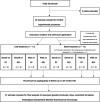Parent artery-initiated and stent-mediated neointima formation in a rat saccular side wall model
- PMID: 35110397
- PMCID: PMC9685721
- DOI: 10.1136/neurintsurg-2021-018297
Parent artery-initiated and stent-mediated neointima formation in a rat saccular side wall model
Abstract
Background: Unlike clipping that forms an immediate barrier of blood flow into intracranial aneurysms, endovascular treatments rely on thrombus organization and neointima formation. Therefore, a continuous endothelial cell layer is crucial to prevent blood flow in the former aneurysm. This study investigates the origin of endothelial cells in the neointima of endovascular treated aneurysms, specifically whether cells from the parent artery play a role in neointima formation.
Methods: In male rats, decellularized and vital side wall aneurysms were treated by coil (n=16) or stent embolization (n=15). The cell tracer CM-Dil dye was injected into the clamped aorta before aneurysm suture to mark initial endothelial cells in the parent artery and enable tracking of their proliferation during follow-up. Aneurysms were analyzed for growth, thrombus formation, and recurrence. Histological evaluation followed with cell counts for specific regions-of-interest.
Results: During follow-up, none of the 31 aneurysms ruptured. Macroscopic residual perfusion was observed in 12/16 rats after coiling and in 1/15 after stenting. Amounts of CM-Dil +cells in coiled versus stented decellularized aneurysms significantly decreased in the thrombus on day 7 (p=0.01) and neointima on day 21 (p=0.04). For vital aneurysms, the number of CM-Dil +cells in the neointima on day 21 showed no significant difference.
Conclusions: Healing patterns were worse in coil-treated than stent-treated aneurysms. Cell migration forming a neointima seemed mainly dependent on the adjacent vessel in decellularized aneurysms, but appeared buoyed by recruitment from aneurysm wall cells in vital aneurysms. Therefore, a cell-rich parent artery might be crucial.
Keywords: aneurysm; coil; intervention; stent; vessel wall.
© Author(s) (or their employer(s)) 2022. Re-use permitted under CC BY-NC. No commercial re-use. See rights and permissions. Published by BMJ.
Conflict of interest statement
Competing interests: None declared.
Figures



Similar articles
-
Topographic distribution of inflammation factors in a healing aneurysm.J Neuroinflammation. 2023 Aug 2;20(1):182. doi: 10.1186/s12974-023-02863-1. J Neuroinflammation. 2023. PMID: 37533024 Free PMC article.
-
Using a Cell-Tracer Injection to Investigate the Origin of Neointima-Forming Cells in a Rat Saccular Side Wall Model.J Vis Exp. 2022 Mar 16;(181). doi: 10.3791/63580. J Vis Exp. 2022. PMID: 35377360
-
Patterns of Neointima Formation After Coil or Stent Treatment in a Rat Saccular Sidewall Aneurysm Model.Stroke. 2021 Mar;52(3):1043-1052. doi: 10.1161/STROKEAHA.120.032255. Epub 2021 Jan 28. Stroke. 2021. PMID: 33504186
-
Aneurysm wall cellularity affects healing after coil embolization: assessment in a rat saccular aneurysm model.J Neurointerv Surg. 2020 Jun;12(6):621-625. doi: 10.1136/neurintsurg-2019-015335. Epub 2019 Dec 23. J Neurointerv Surg. 2020. PMID: 31871070
-
Recurrence of endovascularly and microsurgically treated intracranial aneurysms-review of the putative role of aneurysm wall biology.Neurosurg Rev. 2019 Mar;42(1):49-58. doi: 10.1007/s10143-017-0892-2. Epub 2017 Aug 17. Neurosurg Rev. 2019. PMID: 28819834 Review.
Cited by
-
Endothelialization of PTFE-covered stents for aneurysms and arteriovenous fistulas created in canine carotid arteries.Sci Rep. 2024 Feb 27;14(1):4803. doi: 10.1038/s41598-024-55532-5. Sci Rep. 2024. PMID: 38413764 Free PMC article.
-
Topographic distribution of inflammation factors in a healing aneurysm.J Neuroinflammation. 2023 Aug 2;20(1):182. doi: 10.1186/s12974-023-02863-1. J Neuroinflammation. 2023. PMID: 37533024 Free PMC article.
References
-
- Molyneux AJ, Birks J, Clarke A, et al. . The durability of endovascular coiling versus neurosurgical clipping of ruptured cerebral aneurysms: 18 year follow-up of the UK cohort of the International Subarachnoid Aneurysm Trial (ISAT). Lancet 2015;385:691–7. 10.1016/S0140-6736(14)60975-2 - DOI - PMC - PubMed
